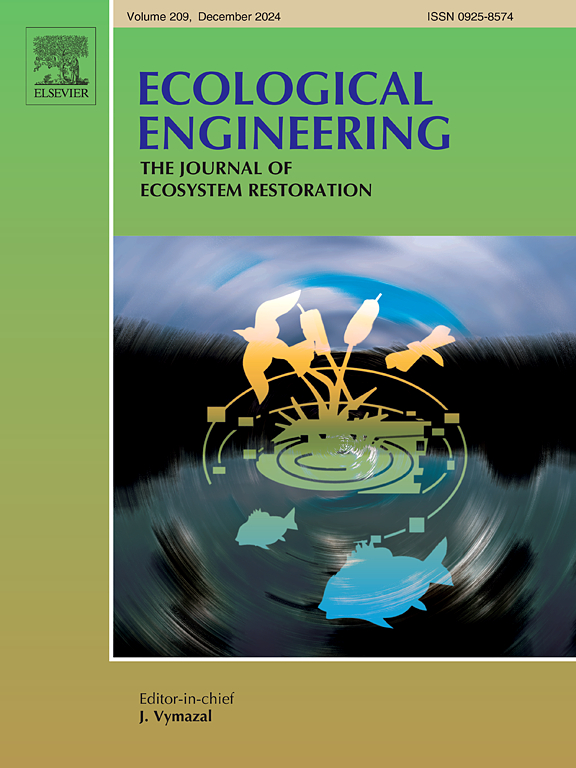Assessing nucleation strategies and spatial dynamics in the restoration of neotropical terrestrial ecosystems: A comprehensive review
IF 4.1
2区 环境科学与生态学
Q1 ECOLOGY
引用次数: 0
Abstract
Neotropical ecosystems have been significantly impacted by agricultural activities and urbanization, causing biodiversity and ecosystem services losses, and requiring extensive restoration efforts. Thus, nucleation strategies appears as a cost-effective restoration method, which promotes ecological succession by establishing vegetation patches that attract fauna and facilitate natural regeneration. Here, we systematically reviewed nucleation techniques applied for Neotropical ecosystems restoration. We assessed the focus and spatial distribution of nucleation in response to stakeholder preferences and land-use types. By examining 58 studies, we identified key aspects of the use of nucleation techniques, emphasizing the need for standardized protocols to optimize nucleation strategies for ecosystem recovery. Overall, 12 nucleation techniques were used in Neotropical ecosystem restoration, with artificial perches, topsoil transfer, seedling islets and brushwood being the most frequent. Stakeholders (i.e., researchers, private sector, and governmental agencies) applied various techniques, with researchers more frequently using multiple and combined techniques. Moreover, we observed that stakeholders and land use affect the spatial patterns of nucleation, whereas their focus only responds to land-use types. Nuclei had an average size of 67.58 m2 ranging from 0.16 m2 to 1225 m2, and techniques focused on flora and fauna showed the greatest spacing between nuclei. Fauna-related techniques were common across all land uses, and the greatest variety of techniques were used in abandoned pastures, former mining sites and protected areas. Although less frequent, using nucleation techniques in combination can contribute to restoration success by addressing multiple objectives. Research-driven innovation is advancing in this field, but single techniques dominate. Advancing the use of combined techniques and standardizing such practices is essential to scale up and optimize nucleation strategies during restoration efforts.
新热带陆地生态系统恢复的成核策略和空间动态评价综述
新热带生态系统受到农业活动和城市化的严重影响,造成生物多样性和生态系统服务丧失,需要广泛的恢复努力。因此,成核策略似乎是一种经济有效的恢复方法,它通过建立植被斑块来吸引动物并促进自然更新,从而促进生态演替。本文系统综述了成核技术在新热带生态系统恢复中的应用。我们根据利益相关者偏好和土地利用类型评估了成核的重点和空间分布。通过研究58项研究,我们确定了成核技术使用的关键方面,强调需要标准化协议来优化生态系统恢复的成核策略。总的来说,在新热带生态系统恢复中,采用了12种成核技术,其中人工栖木、表土转移、幼苗岛和灌丛是最常见的。利益相关者(即研究人员、私营部门和政府机构)应用各种技术,研究人员更频繁地使用多种和组合技术。此外,我们观察到利益相关者和土地利用影响成核的空间格局,而他们的关注点只响应于土地利用类型。核的平均大小为67.58 m2,分布范围为0.16 ~ 1225 m2,以植物群和动物群为中心的核间距最大。与动物有关的技术在所有土地利用中都很常见,在废弃牧场、前矿区和保护区使用的技术种类最多。虽然使用频率较低,但结合使用成核技术可以通过解决多个目标来帮助恢复成功。研究驱动的创新正在这一领域取得进展,但单一技术占主导地位。推进综合技术的使用和标准化这些做法对于扩大和优化恢复工作中的成核策略至关重要。
本文章由计算机程序翻译,如有差异,请以英文原文为准。
求助全文
约1分钟内获得全文
求助全文
来源期刊

Ecological Engineering
环境科学-工程:环境
CiteScore
8.00
自引率
5.30%
发文量
293
审稿时长
57 days
期刊介绍:
Ecological engineering has been defined as the design of ecosystems for the mutual benefit of humans and nature. The journal is meant for ecologists who, because of their research interests or occupation, are involved in designing, monitoring, or restoring ecosystems, and can serve as a bridge between ecologists and engineers.
Specific topics covered in the journal include: habitat reconstruction; ecotechnology; synthetic ecology; bioengineering; restoration ecology; ecology conservation; ecosystem rehabilitation; stream and river restoration; reclamation ecology; non-renewable resource conservation. Descriptions of specific applications of ecological engineering are acceptable only when situated within context of adding novelty to current research and emphasizing ecosystem restoration. We do not accept purely descriptive reports on ecosystem structures (such as vegetation surveys), purely physical assessment of materials that can be used for ecological restoration, small-model studies carried out in the laboratory or greenhouse with artificial (waste)water or crop studies, or case studies on conventional wastewater treatment and eutrophication that do not offer an ecosystem restoration approach within the paper.
 求助内容:
求助内容: 应助结果提醒方式:
应助结果提醒方式:


